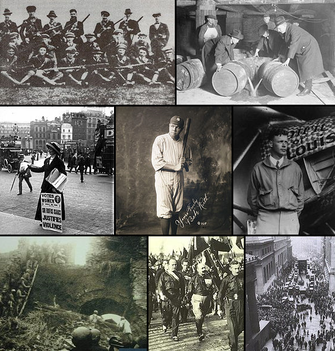
| Millennium |
|---|
| 2nd millennium |
| Centuries |
| Decades |
| Years |
| Categories |
The 1920s (pronounced "nineteen-twenties" often shortened to the "'20s" or the "Twenties") was a decade that began on January 1, 1920, and ended on December 31, 1929. In America, it is frequently referred to as the "Roaring Twenties" or the "Jazz Age", while in Europe the period is sometimes referred to as the "Golden Twenties"[1] because of the economic boom following World War I (1914–1918). French speakers refer to the period as the "Années folles" ("crazy years"),[2] emphasizing the era's social, artistic, and cultural dynamism.
The 1920s saw foreign oil companies begin operations in Venezuela, which became the world's second-largest oil-producing nation.[3] The devastating Wall Street Crash in October 1929 is generally viewed as a harbinger of the end of 1920s prosperity in North America and Europe. In the Soviet Union, the New Economic Policy was created by the Bolsheviks in 1921, to be replaced by the first five-year plan in 1928. The 1920s saw the rise of radical political movements, with the Red Army triumphing against White movement forces in the Russian Civil War, and the emergence of far-right political movements in Europe. In 1922, the fascist leader Benito Mussolini seized power in Italy. Other dictators that emerged included Józef Piłsudski in Poland, and Peter and Alexander Karađorđević in Yugoslavia. First-wave feminism made advances, with women gaining the right to vote in the United States (1920), Albania (1920), Ireland (1921), and with suffrage being expanded in Britain to all women over 21 years old (1928).
In Turkey, nationalist forces defeated Greece, France, Armenia and Britain in the Turkish War of Independence, leading to the Treaty of Lausanne (1923), a treaty more favorable to Turkey than the earlier proposed Treaty of Sèvres. The war also led to the abolition of the Ottoman Caliphate. Nationalist revolts also occurred in Ireland (1919–1921) and Syria (1925–1927). Under Mussolini, Italy pursued a more aggressive domestic and foreign policy, leading to the nigh-eradication of the Sicilian Mafia and the Second Italo-Senussi War in Libya respectively. In 1927, China erupted into a civil war between the Kuomintang (KMT)-led government of the Republic of China (ROC) and forces of the Chinese Communist Party (CCP). Civil wars also occurred in Paraguay (1922–1923), Ireland (1922–1923), Honduras (1924), Nicaragua (1926–1927), and Afghanistan (1928–1929). Saudi forces conquered Jabal Shammar and subsequently, Hejaz.
A severe famine occurred in Russia (1921–1922) due to the combined effects of economic disturbance because of the Russian Revolution and the Russian Civil War, exacerbated by rail systems that could not distribute food efficiently, leading to 5 million deaths. Another severe famine occurred in China (1928–1930), leading to 6 million deaths. The Spanish flu pandemic (1918–1920) and Russian typhus epidemic (1918–1922), which had begun in the previous decade, caused 25–50 million and 2–3 million deaths respectively. Major natural disasters of this decade include the 1920 Haiyuan earthquake (258,707~273,407 deaths), 1922 Shantou typhoon (50,000–100,000 deaths), 1923 Great Kantō earthquake (105,385–142,800 deaths), and 1927 Gulang earthquake (40,912 deaths).
Silent films were popular in this decade, with the highest-grossing film of this decade being either the American silent epic adventure-drama film Ben-Hur: A Tale of the Christ or the American silent war drama film The Big Parade, depending on the metrics used. Sinclair Lewis was a popular author in the United States in the 1920s, with his books Main Street and Elmer Gantry becoming best-sellers. Best-selling books outside the US included the Czech book The Good Soldier Švejk, which sold 20 million copies. Songs of this decade included "Mack the Knife" and "Tiptoe Through the Tulips".
During the 1920s, the world population increased from 1.87 to 2.05 billion, with approximately 700 million births and 525 million deaths in total.
|
Main article: Roaring Twenties |
The Roaring Twenties brought about several novel and highly visible social and cultural trends. These trends, made possible by sustained economic prosperity, were most visible in major cities like New York, Chicago, Paris, Berlin, and London. "Normalcy" returned to politics in the wake of hyper-emotional patriotism during World War I, jazz blossomed, and Art Deco peaked. For women, knee-length skirts and dresses became socially acceptable, as did bobbed hair with a finger wave or marcel wave. The women who pioneered these trends were frequently referred to as flappers.[4]
The era saw the large-scale adoption of automobiles, telephones, motion pictures, radio, and household electricity, as well as unprecedented industrial growth, accelerated consumer demand and aspirations, and significant changes in lifestyle and culture, mostly in the urbanized areas of the Western World. The media began to focus on celebrities, especially sports heroes and movie stars. Large baseball stadiums were built in major U.S. cities, in addition to palatial cinemas.
Most independent countries passed women's suffrage after 1918, especially as a reward for women's support of the war effort and endurance of its deaths and hardships.[citation needed]
|
Main article: International relations (1919–1939) |
|
See also: List of sovereign states in the 1920s |


|
Main article: List of wars: 1900–1944 § 1920–1929 |


|
Main article: Women's suffrage |





Prominent assassinations, targeted killings, and assassination attempts include:
|
Main article: 1920s in film |
Silent films were popular in this decade, with the highest-grossing film of this decade being either 1925 American silent epic adventure-drama film Ben-Hur: A Tale of the Christ or the 1925 American silent war drama film The Big Parade, depending of metrics used: Ben-Hur grossed more during its initial release, but The Big Parade ultimately grossed more via re-releases.
| Year | Title | Worldwide gross | Budget | Reference(s) |
|---|---|---|---|---|
| 1920 | Way Down East | $5,000,000R ($4,000,000)R | $800,000 | [# 1][# 2] |
| 1921 | The Four Horsemen of the Apocalypse | $5,000,000R ($4,000,000)R | $600,000–800,000 | [# 3] |
| 1922 | Douglas Fairbanks in Robin Hood | $2,500,000R | $930,042.78 | [# 4][# 5] |
| 1923 | The Covered Wagon | $5,000,000R | $800,000 | [# 6][# 7] |
| 1924 | The Sea Hawk | $3,000,000R | $700,000 | [# 6] |
| 1925 | The Big Parade | $18,000,000–22,000,000R
($6,131,000)R |
$382,000 | [# 8][# 9][# 10] |
| Ben-Hur | $10,738,000R ($9,386,000)R | $3,967,000 | [# 11][# 12] | |
| 1926 | For Heaven's Sake | $2,600,000R FH | $150,000 | [# 1][# 13] |
| 1927 | Wings | $3,600,000R | $2,000,000 | [# 1][# 14][# 15] |
| 1928 | The Singing Fool | $5,900,000R | $388,000 | [# 15][# 16] |
| 1929 | The Broadway Melody | $4,400,000–4,800,000R | $379,000 | [# 17][# 18] |
| Sunny Side Up | $3,500,000*R SS | $600,000 | [# 19][# 20] |
|
Main article: 1920s in Western fashion |

The 1920s is the decade in which fashion entered the modern era. It was the decade in which women first abandoned the more restricting fashions of past years and began to wear more comfortable clothes (such as short skirts or trousers). Men also abandoned highly formal daily attire and even began to wear athletic clothing for the first time. The suits men wear today are still based, for the most part, on those worn in the late 1920s. The 1920s are characterized by two distinct periods of fashion. In the early part of the decade, change was slow, as many were reluctant to adopt new styles. From 1925, the public passionately embraced the styles associated with the Roaring Twenties. These styles continued to characterize fashion until the worldwide depression worsened in 1931.

|
See also: Radio in 1920s elections |
|
See also: List of years in literature § 1920s, and Publishers Weekly list of bestselling novels in the United States in the 1920s |

The best-selling books of every year in the United States were as follows:[17]





|
Main article: 1920s in film |



|
See also: Bauhaus |

|
See also: History of baseball in the United States § Babe Ruth and the end of the dead-ball era |

